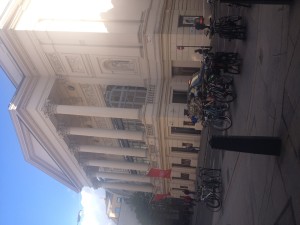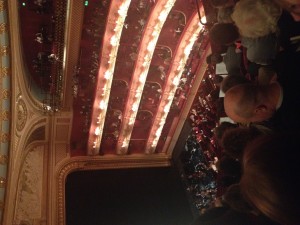Woolf Works – Royal Opera House, London

The thing about having a particular dancer who I like to go and see (Edward Watson, since you asked) rather than being very educated about choreographers, composers or directors of ballet, means that I go to a fairly mixed bag of performances. Had Watson not been dancing in Woolf Works, I’m not sure that the concept of a ‘full-length ballet’ (which is actually three short works, I’m not sure why nobody else has questioned this) based on the works of Virginia Woolf would have been enough of a draw to have me spend an evening at the Royal Opera House. As it was, I had a nice night out, was slightly confused in parts, but felt I could now talk slightly more confidently about the source texts themselves.
Of source texts, there are three. The ballet is in three acts (three separate works, if you will), based respectively on Mrs Dalloway, Orlando and The Waves. Have I read any of these? No. Does that make a difference as how how well you can follow each of the works? Yes. The piece based on Mrs Dalloway I did enjoy both visually and for the dreamy sadness the dancers brought to it. I had a vague idea of the plot, couldn’t tell you who any of the characters were apart from the eponymous Clarissa played by Alessandra Ferri, but the slowly moving ‘frames’ and archival footage worked very well to set the mood of a day spent lost in memories, both sweet and poignant. Watson was excellent as Septimus Smith, but of course I would say that.
When I came back from the interval and Becomings, the piece based on Orlando, began, my first thought was something along the lines of “Surely there are no spaceships in Virginia Woolf?”. Never fear, there were not, I was merely confused by the costumes and lasers, which reminded me strongly of Christmas Yet to Come in Blackadder’s Christmas Carol, for those who have seen it. From what I have read, the choreography in this section was more typical of Wayne McGregor, very kinetic and demanding on the dancers, and it got some rousing applause as the curtain went down again. I was largely confused, had no idea if they were trying for a plot or not, but enjoyed myself.
Again, not knowing the source text, I didn’t realise that the piece based on The Waves was more of a departure from the source text. Opening with Gillian Anderson reading Woolf’s suicide note, it was part reminiscence of a life, as is apparently the case in The Waves only with more characters, part life flashing before one’s eyes as Ferri, as Woolf, is tossed about by the waves and drowns. I found it poignant and beautiful, with the stripped back stage adding to the emotional wrench.
So what is the moral of the story? Firstly, having an arbitrary reason to choose a particular work from a season of ballet (or probably theatre or music for that matter) can be quite a good thing. I saw something I wouldn’t have seen otherwise, was introduced to new ways of staging works of literature, and got to see some cool lasers. Also, however, this evening brought home to me the fact that I can’t always get away with not knowing the source text. Normally, even if it’s Shakespeare I’m going to see, I quite like not reading up about it beforehand, and spending some time on Wikipedia when I get home. In the case of Woolf Works, however, I would undoubtedly have got more out of it had I been able to recognise characters and key moments, and thus been able to understand what was original to Woolf, what was artistic license, and what fell somewhere in between. I may have some homework in future before I head off to see whatever Edward Watson is in next.

